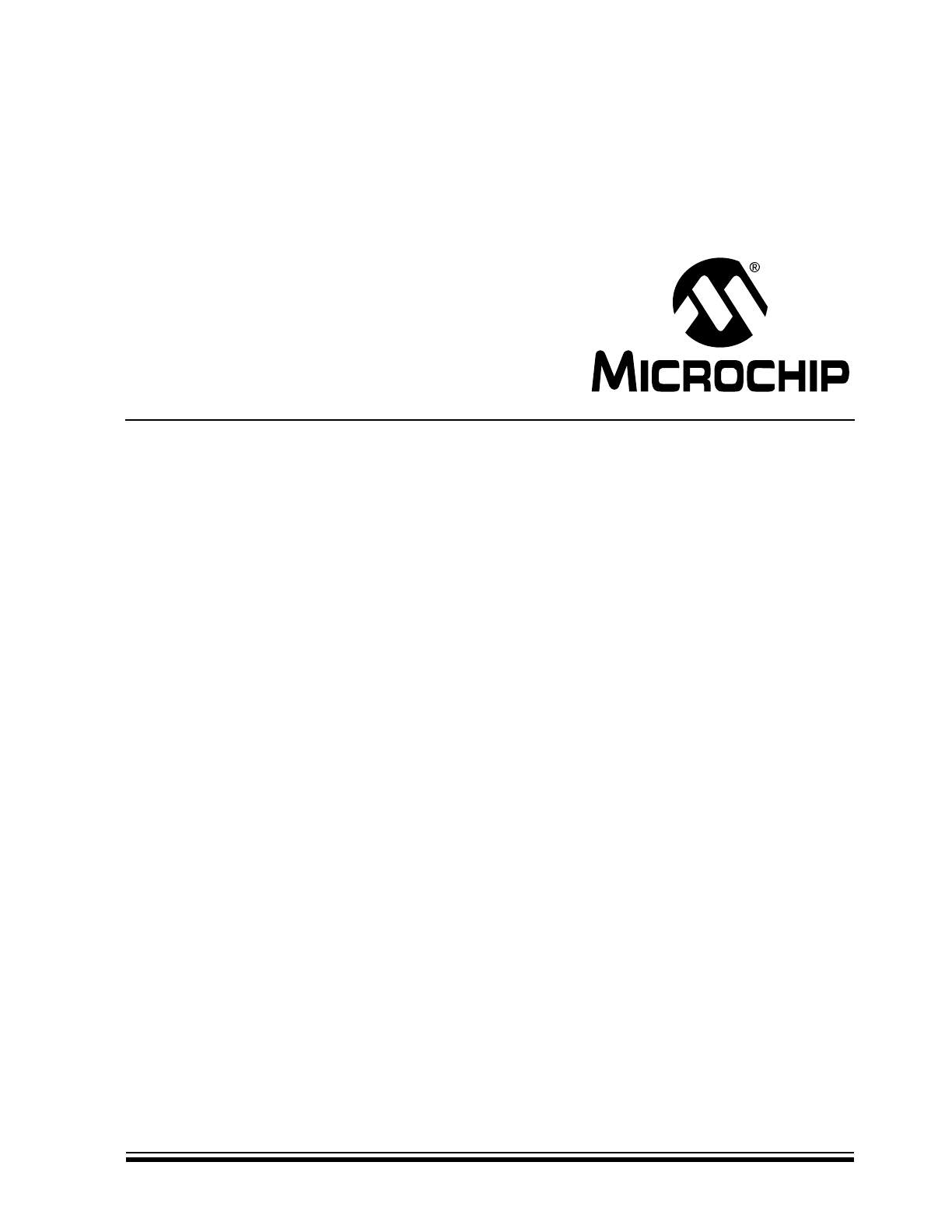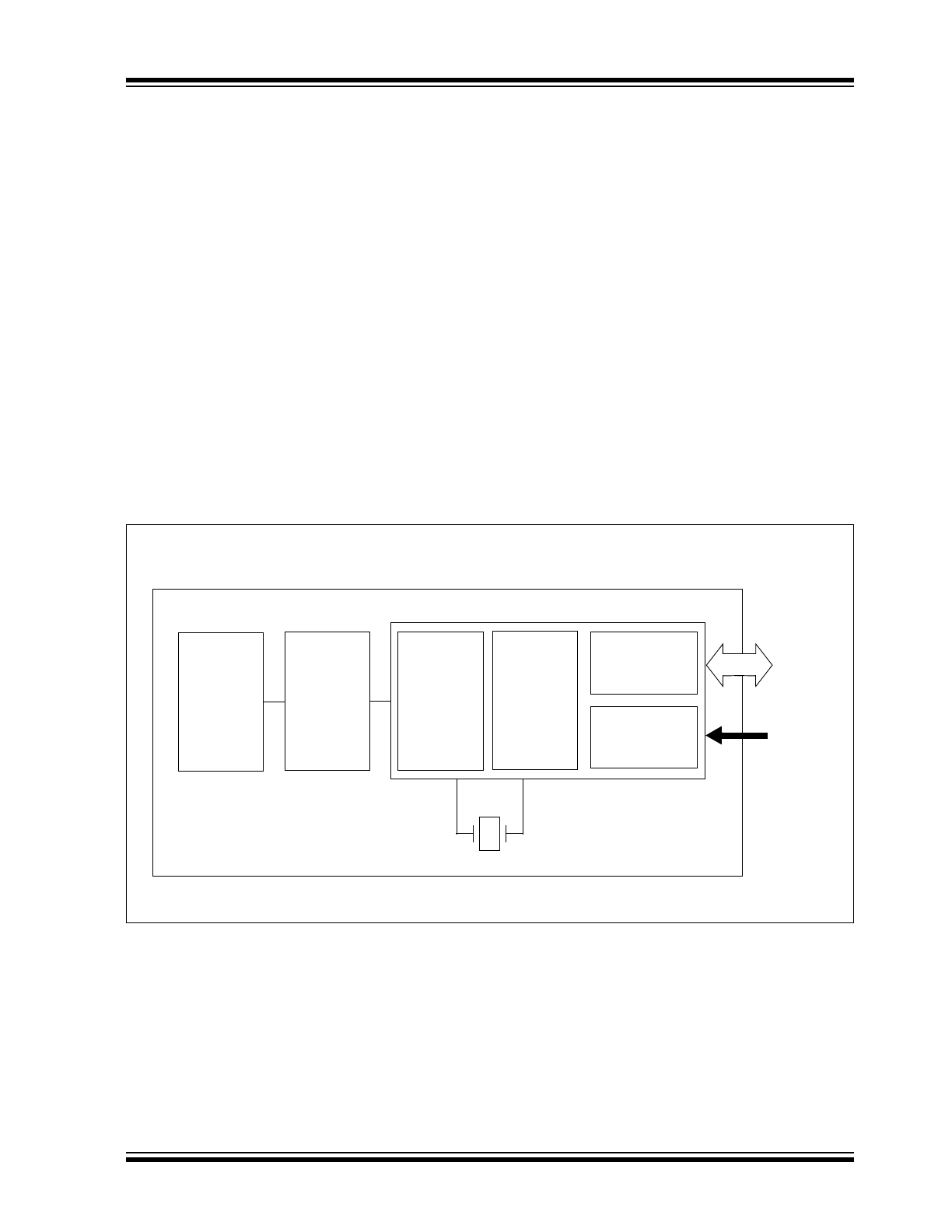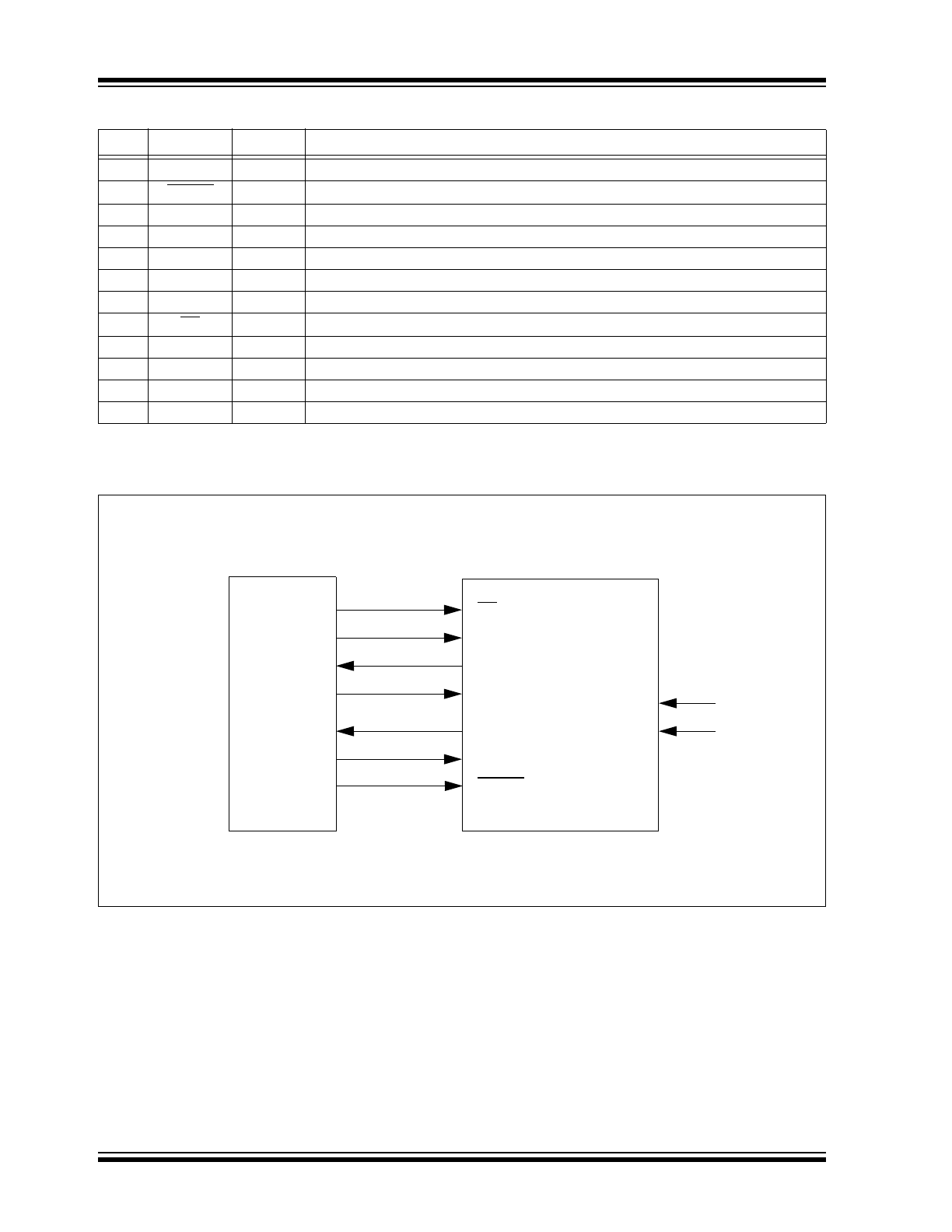
© 2008 Microchip Technology Inc.
DS70329B
MRF24J40MA
Data Sheet
2.4 GHz IEEE Std. 802.15.4™
RF Transceiver Module

DS70329B-page ii
© 2008 Microchip Technology Inc.
Information contained in this publication regarding device
applications and the like is provided only for your convenience
and may be superseded by updates. It is your responsibility to
ensure that your application meets with your specifications.
MICROCHIP MAKES NO REPRESENTATIONS OR
WARRANTIES OF ANY KIND WHETHER EXPRESS OR
IMPLIED, WRITTEN OR ORAL, STATUTORY OR
OTHERWISE, RELATED TO THE INFORMATION,
INCLUDING BUT NOT LIMITED TO ITS CONDITION,
QUALITY, PERFORMANCE, MERCHANTABILITY OR
FITNESS FOR PURPOSE. Microchip disclaims all liability
arising from this information and its use. Use of Microchip
devices in life support and/or safety applications is entirely at
the buyer’s risk, and the buyer agrees to defend, indemnify and
hold harmless Microchip from any and all damages, claims,
suits, or expenses resulting from such use. No licenses are
conveyed, implicitly or otherwise, under any Microchip
intellectual property rights.
Trademarks
The Microchip name and logo, the Microchip logo, Accuron,
dsPIC, K
EE
L
OQ
, K
EE
L
OQ
logo, MPLAB, PIC, PICmicro,
PICSTART, rfPIC, SmartShunt and UNI/O are registered
trademarks of Microchip Technology Incorporated in the
U.S.A. and other countries.
FilterLab, Linear Active Thermistor, MXDEV, MXLAB,
SEEVAL, SmartSensor and The Embedded Control Solutions
Company are registered trademarks of Microchip Technology
Incorporated in the U.S.A.
Analog-for-the-Digital Age, Application Maestro, CodeGuard,
dsPICDEM, dsPICDEM.net, dsPICworks, dsSPEAK, ECAN,
ECONOMONITOR, FanSense, In-Circuit Serial
Programming, ICSP, ICEPIC, Mindi, MiWi, MPASM, MPLAB
Certified logo, MPLIB, MPLINK, mTouch, PICkit, PICDEM,
PICDEM.net, PICtail, PIC
32
logo, PowerCal, PowerInfo,
PowerMate, PowerTool, REAL ICE, rfLAB, Select Mode, Total
Endurance, WiperLock and ZENA are trademarks of
Microchip Technology Incorporated in the U.S.A. and other
countries.
SQTP is a service mark of Microchip Technology Incorporated
in the U.S.A.
All other trademarks mentioned herein are property of their
respective companies.
© 2008, Microchip Technology Incorporated, Printed in the
U.S.A., All Rights Reserved.
Printed on recycled paper.
Note the following details of the code protection feature on Microchip devices:
•
Microchip products meet the specification contained in their particular Microchip Data Sheet.
•
Microchip believes that its family of products is one of the most secure families of its kind on the market today, when used in the
intended manner and under normal conditions.
•
There are dishonest and possibly illegal methods used to breach the code protection feature. All of these methods, to our
knowledge, require using the Microchip products in a manner outside the operating specifications contained in Microchip’s Data
Sheets. Most likely, the person doing so is engaged in theft of intellectual property.
•
Microchip is willing to work with the customer who is concerned about the integrity of their code.
•
Neither Microchip nor any other semiconductor manufacturer can guarantee the security of their code. Code protection does not
mean that we are guaranteeing the product as “unbreakable.”
Code protection is constantly evolving. We at Microchip are committed to continuously improving the code protection features of our
products. Attempts to break Microchip’s code protection feature may be a violation of the Digital Millennium Copyright Act. If such acts
allow unauthorized access to your software or other copyrighted work, you may have a right to sue for relief under that Act.
Microchip received ISO/TS-16949:2002 certification for its worldwide
headquarters, design and wafer fabrication facilities in Chandler and
Tempe, Arizona; Gresham, Oregon and design centers in California
and India. The Company’s quality system processes and procedures
are for its PIC
®
MCUs and dsPIC
®
DSCs, K
EE
L
OQ
®
code hopping
devices, Serial EEPROMs, microperipherals, nonvolatile memory and
analog products. In addition, Microchip’s quality system for the design
and manufacture of development systems is ISO 9001:2000 certified.

© 2008 Microchip Technology Inc.
DS70329B-page 1
MRF24J40MA
Features:
• IEEE Std. 802.15.4™ Compliant RF Transceiver
• Supports ZigBee
®
, MiWi™, MiWi™ P2P and
Proprietary Wireless Networking Protocols
• Small Size: 0.7” x 1.1” (17.8 mm x 27.9 mm),
Surface Mountable
• Integrated Crystal, Internal Voltage Regulator,
Matching Circuitry and PCB Antenna
• Easy Integration into Final Product – Minimize
Product Development, Quicker Time to Market
• Radio Regulation Certification for United States
(FCC), Canada (IC) and Europe (ETSI)
• Compatible with Microchip Microcontroller
Families (PIC16F, PIC18F, PIC24F/H, dsPIC33
and PIC32)
• Up to 400 ft. Range
Operational:
• Operating Voltage: 2.4-3.6V (3.3V typical)
• Temperature Range: -40
°C to +85°C Industrial
• Simple, Four-Wire SPI Interface
• Low-Current Consumption:
- RX mode: 19 mA (typical)
- TX mode: 23 mA (typical)
- Sleep: 2
μA (typical)
RF/Analog Features:
• ISM Band 2.405-2.48 GHz Operation
• Data Rate: 250 kbps
• -94 dBm Typical Sensitivity with +5 dBm
Maximum Input Level
• +0 dBm Typical Output Power with
36 dB TX Power Control Range
• Integrated Low Phase Noise VCO, Frequency
Synthesizer and PLL Loop Filter
• Digital VCO and Filter Calibration
• Integrated RSSI ADC and I/Q DACs
• Integrated LDO
• High Receiver and RSSI Dynamic Range
MAC/Baseband Features:
• Hardware CSMA-CA Mechanism, Automatic ACK
Response and FCS Check
• Independent Beacon, Transmit and GTS FIFO
• Supports all CCA modes and RSS/LQI
• Automatic Packet Retransmit Capable
• Hardware Security Engine (AES-128) with CTR,
CCM and CBC-MAC modes
• Supports Encryption and Decryption for MAC
Sublayer and Upper Layer
FIGURE 1:
PIN DIAGRAM
2
3
4
5
6
1
7
V
IN
GND
8
9
10
RESET
WAKE
SDO
SDI
SCK
CS
NC
GND
INT
12
11
GND
2.4 GHz IEEE Std. 802.15.4™ RF Transceiver Module

MRF24J40MA
DS70329B-page 2
© 2008 Microchip Technology Inc.
Table of Contents
1.0
Device Overview .......................................................................................................................................................................... 3
2.0
Circuit Description ........................................................................................................................................................................ 7
3.0
Regulatory Approval ................................................................................................................................................................... 15
4.0
Electrical Characteristics ............................................................................................................................................................ 19
Appendix A: Revision History............................................................................................................................................................... 21
Index .................................................................................................................................................................................................... 23
The Microchip Web Site ....................................................................................................................................................................... 25
Customer Change Notification Service ................................................................................................................................................ 25
Customer Support ................................................................................................................................................................................ 25
Reader Response ................................................................................................................................................................................ 26
Product Identification System............................................................................................................................................................... 27
TO OUR VALUED CUSTOMERS
It is our intention to provide our valued customers with the best documentation possible to ensure successful use of your Microchip
products. To this end, we will continue to improve our publications to better suit your needs. Our publications will be refined and
enhanced as new volumes and updates are introduced.
If you have any questions or comments regarding this publication, please contact the Marketing Communications Department via
E-mail at docerrors@microchip.com or fax the Reader Response Form in the back of this data sheet to (480) 792-4150. We
welcome your feedback.
Most Current Data Sheet
To obtain the most up-to-date version of this data sheet, please register at our Worldwide Web site at:
http://www.microchip.com
You can determine the version of a data sheet by examining its literature number found on the bottom outside corner of any page.
The last character of the literature number is the version number, (e.g., DS30000A is version A of document DS30000).
Errata
An errata sheet, describing minor operational differences from the data sheet and recommended workarounds, may exist for current
devices. As device/documentation issues become known to us, we will publish an errata sheet. The errata will specify the revision
of silicon and revision of document to which it applies.
To determine if an errata sheet exists for a particular device, please check with one of the following:
• Microchip’s Worldwide Web site; http://www.microchip.com
• Your local Microchip sales office (see last page)
When contacting a sales office, please specify which device, revision of silicon and data sheet (include literature number) you are
using.
Customer Notification System
Register on our web site at www.microchip.com to receive the most current information on all of our products.

© 2008 Microchip Technology Inc.
DS70329B-page 3
MRF24J40MA
1.0
DEVICE OVERVIEW
The MRF24J40MA is a 2.4 GHz IEEE Std. 802.15.4™
compliant, surface mount module with integrated
crystal, internal voltage regulator, matching circuitry
and PCB antenna. The MRF24J40MA module oper-
ates in the non-licensed 2.4 GHz frequency band and
is FCC, IC and ETSI compliant. The integrated module
design frees the integrator from extensive RF and
antenna design, and regulatory compliance testing,
allowing quicker time to market.
The MRF24J40MA module is compatible with
Microchip’s ZigBee
®
, MiWi™ and MiWi P2P software
stacks. Each software stack is available as a free
download, including source code, from the Microchip
web site http://www.microchip.com/wireless.
The MRF24J40MA module has received regulatory
approvals for modular devices in the United States
(FCC), Canada (IC) and Europe (ETSI). Modular
approval removes the need for expensive RF and
antenna design and allows the end user to place the
MRF24J40MA module inside a finished product and
not require regulatory testing for an intentional radiator
(RF transmitter). See Section 3.0 “Regulatory
Approval” for specific requirements to be followed by
the integrator.
1.1
Interface Description
Figure 1-1 shows a simplified block diagram of the
MRF24J40MA module. The module is based on the
Microchip Technology MRF24J40 IEEE 802.15.4™
2.4 GHz RF Transceiver IC. The module interfaces to
many popular Microchip PIC
®
microcontrollers via a
4-wire serial SPI interface, interrupt, wake, Reset,
power and ground, as shown in Figure 1-2. Table 1-1
provides the pin descriptions.
Data communications with the MRF24J40MA module
are documented in the “MRF24J40 IEEE 802.15.4™
2.4 GHz RF Transceiver Data Sheet” (DS39776). Refer
to the MRF24J40 Data Sheet for specific serial
interface protocol and register definitions.
FIGURE 1-1:
MRF24J40MA BLOCK DIAGRAM
PCB
Antenna
Matching
Circuitry
Physical
MAC
Interface
Power
Management
SPI
20 MHz
Crystal
Digital
I/O
Power
MRF24J40MA IEEE Std. 802.15.4™ Module
MRF24J40

MRF24J40MA
DS70329B-page 4
© 2008 Microchip Technology Inc.
TABLE 1-1:
PIN DESCRIPTION
FIGURE 1-2:
MICROCONTROLLER TO MRF24J40MA INTERFACE
Pin
Symbol
Type
Description
1
GND
Power
Ground
2
RESET
DI
Global hardware Reset pin
3
WAKE
DI
External wake-up trigger
4
INT
DO
Interrupt pin to microcontroller
5
SDI
DI
Serial interface data input
6
SCK
DI
Serial interface clock
7
SDO
DO
Serial interface data output from MRF24J40
8
CS
DI
Serial interface enable
9
NC
—
No connection (allow pin to float; do not connect signal)
10
V
IN
Power
Power supply
11
GND
Ground
Ground
12
GND
Ground
Ground
Legend: Pin type abbreviation: D = Digital, I = Input, O = Output
SDO
I/O
SDI
SCK
INTx
MRF24J40MA
CS
SDI
SDO
SCK
INT
I/O
WAKE
V
IN
GND
PIC
®
MCU
I/O
RESET

© 2008 Microchip Technology Inc.
DS70329B-page 5
MRF24J40MA
1.2
Mounting Details
The MRF24J40MA is a surface mountable module.
Module dimensions are shown in Figure 1-3. The
module Printed Circuit Board (PCB) is 0.032" thick with
castellated mounting points on the edge. Figure 1-4 is
a recommended host PCB footprint for the
MRF24J40MA.
The MRF24J40MA has an integrated PCB antenna.
For the best performance, follow the mounting details
shown in Figure 1-5. It is recommended that the
module be mounted on the edge of the host PCB, and
an area around the antenna, approximately 1.2", be
kept clear of metal objects. A host PCB ground plane
around the MRF24J40MA acts as a counterpoise to the
PCB antenna. It is recommended to extend the ground
plane at least 0.4" around the module.
FIGURE 1-3:
MODULE DETAILS
FIGURE 1-4:
RECOMMENDED PCB
FOOTPRINT

MRF24J40MA
DS70329B-page 6
© 2008 Microchip Technology Inc.
FIGURE 1-5:
MOUNTING DETAILS
0.470”
Edge of PCB
Keep area around antenna
(approximately 1.2 inches)
clear of metallic structures
for best performance
PCB Ground Plane (Counterpoise)
Extend as far as possible to
the sides and below the module
(at least 0.4 inches on each side)
for best performance
0.4”
0.4”
0.4”
1.2”
1.2”

© 2008 Microchip Technology Inc.
Advance Information
DS70329B-page 7
MRF24J40MA
2.0
CIRCUIT DESCRIPTION
The MRF24J40MA is a complete 2.4 GHz IEEE
Std. 802.15.4™ compliant surface mount module with
integrated crystal, internal voltage regulator, matching
circuitry and PCB antenna. The MRF24J40MA module
interfaces to many popular Microchip PIC micro-
controllers via a 4-wire serial SPI interface, interrupt,
wake, Reset, power and ground. Data communications
with the MRF24J40MA module are documented in the
“MRF24J40 IEEE 802.15.4™ 2.4 GHz RF Transceiver
Data Sheet” (DS39776). Refer to the MRF24J40 Data
Sheet for specific serial interface protocol and register
definitions.
2.1
Schematic
A schematic diagram of the module is shown in
Figure 2-1 and the Bill of Materials (BOM) is shown in
Table 2-1.
The MRF24J40MA module is based on the Microchip
Technology MRF24J40 IEEE 802.15.4™ 2.4 GHz RF
Transceiver IC. The serial I/O (SCK, SDI, SDO and
CS), RESET, WAKE and INT pins are brought out to
the module pins. The SDO signal is tri-state buffered by
IC2 to solve a silicon errata, where the SDO signal
does not release to a high-impedance state, after the
CS pin returns to its inactive state. Crystal, X1, is a
20 MHz crystal with a frequency tolerance of
±10 ppm @ 25°C to meet the IEEE Std. 802.15.4
symbol rate tolerance of ±40 ppm. A balun is formed by
components: L1, L3, C2 and C14. L2 is an RF choke
and pull-up for the RFP and RFN pins on the
MRF24J40. C15 is a DC block capacitor. A low-pass
filter is formed by components: L4, C16 and C17. The
remaining capacitors provide RF and digital bypass.

MRF24J40MA
DS70329B-page 8
Advance Information
© 2008 Microchip Technology Inc.
FIGURE 2-1:
MRF24J40MA SCHEMATIC
V
DD
1
RF
P
2
RF
N
3
V
DD
4
V
DD
5
GN
D
6
G
P
IO0
7
G
P
IO1
8
G
P
IO5
9
G
P
IO4
10
NC
30
NC
29
LP
O
S
C
1
28
LP
O
S
C
2
27
NC
26
GND
25
GND
24
NC
23
GND
22
V
DD
21
IC1
GPIO2
11
GPIO3
12
RESET
13
GND
14
WAKE
15
INT
16
SDO
17
SDI
18
SCK
19
CS
20
40
39
38
37
36
35
34
33
32
31
LCA
P
V
DD
NC
V
DD
GND
V
DD
OSC
1
OCS
2
V
DD
V
DD
M
R
F2
4J4
0/M
L
NC
NC
NC
NC
NC
NC
C1
0
47 p
F
V
IN
C1
1
0.1
μ
F
V
IN
L2 3
.3 nH
L1 8
.2 nH
V
IN
C2
1.0
pF
L3
5.6
nH
C1
4
0.
5 pF
C1
3
47
pF
C1
2
0.
1
μ
F
C1
5
0.5
pF
C1
6
NP
C1
7
1.0
pF
PCB
An
te
n
n
a
L4
6.8 nH
V
IN
2
RESET
4 I
N
T
3
WAKE
5 S
D
I
6 S
C
K
8 C
S
NC
OE
A
V
IN
GN
D
Y
V
CC
1
2
IC
2
N
C
7S
Z1
25
P
5
X
7 S
D
O
3
5
4
C3
0.0
1
μ
F
V
IN
R1
NP
12
GN
D
1 G
N
D
11
GN
D
10
V
IN
V
IN
C1
1
μF
C6
47 pF
V
IN
C4
47
pF
V
IN
C5
47 pF
V
IN
C1
8
18 pF
C1
9
18
pF
X
1
20
.00 MH
z
C9
10
0 p
F
C7
0.01
μ
F
V
IN
C8
1
μF
V
IN
No
te
:
NP = No
t Pla
c
e
d
.
